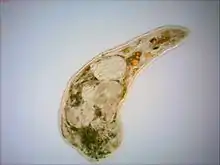Rhabdocoela
Rhabdocoela is an order of flatworms in the class Rhabditophora with about 1700 species described worldwide. Most of rhabdocoels are free-living organisms, but some live symbiotically with other animals.[1]
| Rhabdocoela | |
|---|---|
 | |
| Strongylostoma elongatum spinosum. | |
| Scientific classification | |
| Kingdom: | Animalia |
| Phylum: | Platyhelminthes |
| Class: | Rhabditophora |
| Subterclass: | Euneoophora |
| Order: | Rhabdocoela Meixner, 1925 |
| Suborders | |
Description
Although Rhabdocoela is a highly supported group in molecular studies, there is no clear morphological synapomorphy that unites them. All rhabdocoels have a bulbous pharynx, but this is shared with other flatworm groups, such as Neodermata, Lecithoepitheliata and some species of Prolecithophora.[2]
Some possibly identified synapomorphies are found in the ultrastructure of the protonephridial system, but similar constructions exist in other groups. Another possible apomorphy is found in the ultrastructure of the sperm, which has a dense heel on the basal bodies during spermiogenesis, but some groups have lost this feature.[2]
Classification
Rhabdocoels were traditionally classified in two groups, Dalyellioida and Typhloplanoida, although this system was suspected to be artificial. Later, molecular studies have shown that these groups were not monophyletic.[3] One subgroup of Dalyellioida, Fecampiida, does not group within Rhabdocoela, but is closely related to Tricladida and Prolecithophora. The group Kalyptorhynchia, previously a subgroup of Thyphloplanoida, appears to be the sister-group of all other rhabdocoels, which form a clade named Dalytyphloplanida.[2]
Ecology
Most rhabdocoels are freshwater organisms. Some groups, such as typhloplanids, are predators, the main prey being cladocerans.[4] Others feed on algae and may incorporate them in their tissues.[5]
The temnocephalidans all live as ectosymbionts or parasites of other freshwater animals, such as arthropods, mollusks, and turtles.[6]
References
- Tessens, Bart; Janssen, Toon; Artois, Tom (2014). "Molecular phylogeny of Kalyptorhynchia (Rhabdocoela, Platyhelminthes) inferred from ribosomal sequence data". Zoologica Scripta. 43 (5): 519–530. doi:10.1111/zsc.12066. ISSN 0300-3256.
- Willems, Wim R.; Wallberg, Andreas; Jondelius, Ulf; Littlewood, David T. J.; Backeljau, Thierry; Schockaert, Ernest R.; Artois, Tom J. (2006). "Filling a gap in the phylogeny of flatworms: relationships within the Rhabdocoela (Platyhelminthes), inferred from 18S ribosomal DNA sequences". Zoologica Scripta. 35 (1): 1–17. doi:10.1111/j.1463-6409.2005.00216.x. hdl:1942/1609. ISSN 0300-3256.
- Littlewood, D. T. J.; Rohde, K.; Clough, K. A. (1999). "The interrelationships of all major groups of Platyhelminthes: phylogenetic evidence from morphology and molecules". Biological Journal of the Linnean Society. 66 (1): 75–114. doi:10.1111/j.1095-8312.1999.tb01918.x. ISSN 0024-4066.
- Dumont, Henri; Rietzler, Arnola; Han, Bo-Ping (2014). "A review of typhloplanid flatworm ecology, with emphasis on pelagic species". Inland Waters. 4 (3): 257–270. doi:10.5268/IW-4.3.558. ISSN 2044-2041.
- Douglas, Angela E. (2007). "Experimental studies on symbioticChlorellain the Neorhabdocoel Turbellaria Dalyellia viridis and Typhloplana viridata". British Phycological Journal. 22 (2): 157–161. doi:10.1080/00071618700650181. ISSN 0007-1617.
- Cristina Damborenea, M.; Cannon, Lester R. G. (2001). "On neotropical Temnocephala (Platyhelminthes)". Journal of Natural History. 35 (8): 1103–1118. doi:10.1080/00222930152434454. ISSN 0022-2933.